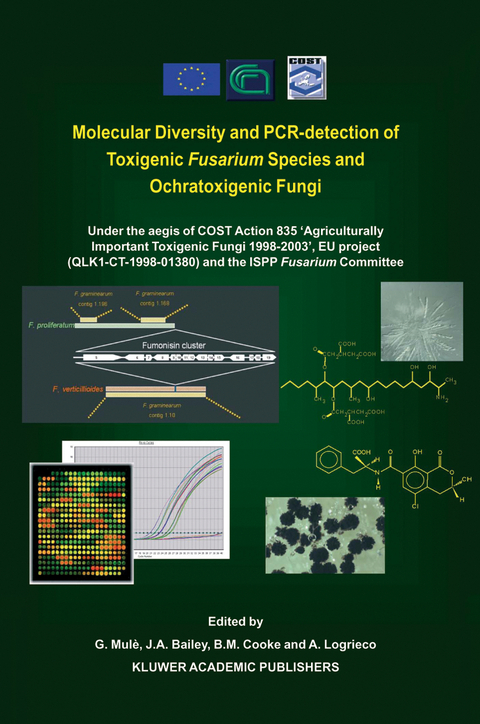
Molecular Diversity and PCR-detection of Toxigenic Fusarium Species and Ochratoxigenic Fungi
Springer-Verlag New York Inc.
978-1-4020-2284-5 (ISBN)
Phylogeny and molecular diagnosis of mycotoxigenic fungi.- FUSARIUM-ID v. 1.0: A DNA sequence database for identifying Fusarium.- Quantitative detection of Fusarium species in wheat using TaqMan.- A species-specific PCR assay based on the calmodulin partial gene for identification of Fusarium verticillioides, F. proliferatum and F. subglutinans.- Detection and differentiation of trichothecene and enniatin-producing Fusarium species on smallgrain cereals.- Differentiation of Fusarium verticillioides from banana fruits by IGS and EF-1? sequence analyses.- Genetic markers for the analysis of variability and for production of specific diagnostic sequences in fumonisin-producing strains of Fusarium verticillioides.- Synteny in toxigenic Fusarium species: The fumonisin gene cluster and the mating type region as examples.- Mitochondrial DNA diversity and lineage determination of European isolates of Fusarium graminearum (Gibberella zeae).- Genetic diversity of Fusarium graminearum in Europe and Asia.- Mitochondrial DNA variability in Fusarium proliferatum (Gibberella intermedia).- Molecular and morphological diversity of Fusarium species in Finland and northwestern Russia.- Mycotoxin production and molecular variability of European and American isolates of Fusarium culmorum.- Toxin profile, fertility and AFLP analysis of Fusarium verticillioides from banana fruits.- Interfertility of two mating populations in the Gibberella fujikuroi species complex.- Identification of growth stage specific transcript profiles in Fusarium proliferatum (Gibberella fujiknroi, mating population D) by cDNA-AFLP analysis.- Molecular diversity of agriculturally important Aspergillus species.- PCR assay for identification of Aspergillus carbonarius and Aspergillus japonicus.- Production ofochratoxin A by Aspergillus ochraceus.- Analysis of differentially-expressed ochratoxin A biosynthesis genes of Penicillium nordicum.
| Erscheint lt. Verlag | 27.7.2004 |
|---|---|
| Zusatzinfo | 7 Illustrations, color; 72 Illustrations, black and white; VII, 221 p. 79 illus., 7 illus. in color. |
| Verlagsort | New York, NY |
| Sprache | englisch |
| Maße | 193 x 260 mm |
| Themenwelt | Naturwissenschaften ► Biologie ► Botanik |
| Naturwissenschaften ► Biologie ► Genetik / Molekularbiologie | |
| Naturwissenschaften ► Biologie ► Mikrobiologie / Immunologie | |
| Naturwissenschaften ► Biologie ► Mykologie | |
| ISBN-10 | 1-4020-2284-0 / 1402022840 |
| ISBN-13 | 978-1-4020-2284-5 / 9781402022845 |
| Zustand | Neuware |
| Informationen gemäß Produktsicherheitsverordnung (GPSR) | |
| Haben Sie eine Frage zum Produkt? |
aus dem Bereich


